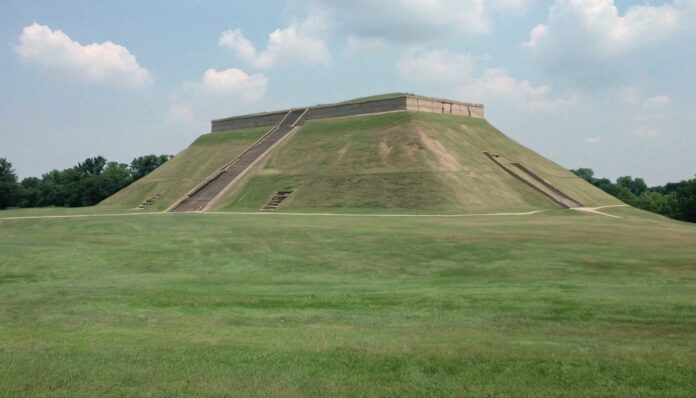Cahokia Mounds is a fascinating and mysterious archaeological site located near modern-day St. Louis, Missouri, in the USA. This site was once a bustling city inhabited by ancient Native Americans. Let’s explore some interesting facts about this incredible place.
What is Cahokia Mounds?
Cahokia Mounds is an area filled with large earthen mounds built by the Mississippian people. These mounds were constructed for various purposes, including as platforms for buildings, burial sites, and ceremonial purposes. The site covers around 2,200 acres and includes more than 80 mounds.
About 1,500 years ago, Cahokia was one of the largest and most influential cities in North America. At its peak, around the year 1050 AD, it had a population of about 20,000 to 40,000 people. This made it larger than many European cities at the time.
Monks Mound
The largest mound at Cahokia is called Monks Mound. It is a massive structure that rises about 100 feet high and covers 14 acres. It is named after French monks who lived nearby in the 1800s. Monks Mound was likely the central focus of the city and may have been the site of important buildings and ceremonies.
A Solar Calendar
One of the most intriguing discoveries at Cahokia is Woodhenge, a series of large wooden posts arranged in circles. Archaeologists believe this structure served as a solar calendar, similar to England’s Stonehenge. The posts helped the Cahokians track the seasons and important solar events.
Mysterious Decline
Despite its success, Cahokia was abandoned around the year 1350. Scientists are still unsure why the city was deserted. Theories suggest environmental changes, resource depletion, social unrest, or a combination of these factors. The fate of the Cahokians remains one of the great mysteries of North American archaeology.
Cahokia Mounds is a UNESCO World Heritage Site, recognizing its importance as a major prehistoric urban center. The site provides valuable insights into the lives and culture of the Mississippian people.
Visiting Cahokia Mounds
Today, Cahokia Mounds is a state historic site open to the public. Visitors can explore the mounds, walk along interpretive trails, and learn about the history and culture of the Mississippian people at the on-site museum. Climbing Monks Mound offers a panoramic view of the surrounding area and a glimpse into the past.
Interesting Facts About Cahokia Mounds
- Largest Pre-Columbian City North of Mexico: At its height, Cahokia was the largest and most influential urban center in North America north of Mexico. Its size and complexity rivaled many contemporary European cities.
- Mystery of the Disappearance: The rapid decline and eventual abandonment of Cahokia around 1350 AD remain one of archaeology’s great mysteries. Despite extensive research, the exact reasons why the city was deserted are still unknown.
- Sophisticated Engineering: The construction of the mounds required sophisticated engineering skills. The builders moved millions of cubic feet of earth without the use of the wheel or draft animals, indicating highly organized labor.
- Chunkey Game: The people of Cahokia played a game called chunkey, which involved rolling a disc-shaped stone across the ground and throwing spears to land as close as possible to where the stone stopped. This game was not only recreational but also had significant cultural and possibly religious importance.
- Widespread Trade Networks: Artifacts found at Cahokia include materials such as copper from the Great Lakes, shells from the Gulf Coast, and mica from the Appalachian Mountains, indicating extensive trade networks.
- Human Sacrifices: Some burial mounds at Cahokia reveal evidence of human sacrifices. These findings suggest complex religious rituals and a society with a hierarchy where certain individuals had significant power and influence.
- Environmental Impact: The rapid growth of Cahokia might have led to environmental stress. Deforestation for building materials and fuel, along with intensive agriculture, could have contributed to the city’s decline.
- Complex Social Structure: Cahokia had a highly stratified society with elites who lived on the largest mounds, commoners in surrounding areas, and possibly even slaves. This indicates a complex social and political structure.
- Cultural Influence: Cahokia’s influence extended far beyond its immediate region. Evidence of Cahokian cultural practices and artifacts has been found throughout the Mississippi Valley, indicating its significant impact on neighboring societies.
- Astronomical Alignments: Some mounds and structures at Cahokia are aligned with celestial events such as solstices and equinoxes, showcasing the inhabitants’ sophisticated understanding of astronomy.
